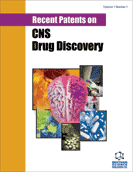Abstract
Alzheimer’s disease (AD) is a rapidly growing disease that is estimated to affect about 36 million people worldwide, therefore there is an immediate need for its’ early diagnosis and treatment. A number of research studies are performed on possible accurate and reliable diagnostic biomarkers of AD. This review study provides an update on the cerebrospinal fluid (CSF) proteins that are being currently used in clinical practice and studied as biomarkers for early AD diagnosis and their future prospects, as well as relevant patents.
Keywords: Alzheimer’s disease (AD), Abeta42, cytochrome c, secretases, Tau.
Recent Patents on CNS Drug Discovery (Discontinued)
Title:The Role of Cerebrospinal Fluid Biomarkers for Alzheimer’s Disease Diagnosis. Where are we Now?
Volume: 8 Issue: 1
Author(s): Vasileios T. Papaliagkas
Affiliation:
Keywords: Alzheimer’s disease (AD), Abeta42, cytochrome c, secretases, Tau.
Abstract: Alzheimer’s disease (AD) is a rapidly growing disease that is estimated to affect about 36 million people worldwide, therefore there is an immediate need for its’ early diagnosis and treatment. A number of research studies are performed on possible accurate and reliable diagnostic biomarkers of AD. This review study provides an update on the cerebrospinal fluid (CSF) proteins that are being currently used in clinical practice and studied as biomarkers for early AD diagnosis and their future prospects, as well as relevant patents.
Export Options
About this article
Cite this article as:
Papaliagkas T. Vasileios, The Role of Cerebrospinal Fluid Biomarkers for Alzheimer’s Disease Diagnosis. Where are we Now?, Recent Patents on CNS Drug Discovery (Discontinued) 2013; 8 (1) . https://dx.doi.org/10.2174/1574889811308010006
| DOI https://dx.doi.org/10.2174/1574889811308010006 |
Print ISSN 1574-8898 |
| Publisher Name Bentham Science Publisher |
Online ISSN 2212-3954 |
 38
38Related Articles
-
Drug Delivery to CNS: Challenges and Opportunities with Emphasis on Biomaterials Based Drug Delivery Strategies
Current Pharmaceutical Design Increased Alzheimer’s Disease Neuropathology is Associated with Type 2 Diabetes and ApoE ε4 Carrier Status
Current Alzheimer Research The Frequency of Thrombotic Events Among Adults Given Antifibrinolytic Drugs for Spontaneous Bleeding: Systematic Review and Meta-Analysis of Observational Studies and Randomized Trials
Current Drug Safety Posterior Reversible Encephalopathy Syndrome with Atypical Presentation: A Pictorial Review on MR Imaging Features
Current Medical Imaging Patent Selections
Recent Patents on Materials Science Cruciferous Plants: Phytochemical Toxicity Versus Cancer Chemoprotection
Mini-Reviews in Medicinal Chemistry Hepatocyte Growth Factor (HGF): Neurotrophic Functions and Therapeutic Implications for Neuronal Injury/Diseases
Current Signal Transduction Therapy Alzheimers Disease (AD) and Mild Cognitive Impairment (MCI) Patients are Characterized by Increased BDNF Serum Levels
Current Alzheimer Research Hypoxia-Inducible Factor-1α Contributes to Brain Edema after Stroke by Regulating Aquaporins and Glycerol Distribution in Brain
Current Neurovascular Research Functional Role of Lipoprotein Receptors in Alzheimers Disease
Current Alzheimer Research The Valsalva Maneuver and Alzheimers Disease: Is there a link?
Current Alzheimer Research Intracranial MR Dynamics in Clinically Diagnosed Alzheimers Disease: The Emerging Concept of “Pulse Wave Encephalopathy”
Current Alzheimer Research The Safety of Medications for the Treatment of Bipolar Disorder During Pregnancy and the Puerperium
Current Drug Safety Serum S-100B Protein as A Biochemical Marker of Brain Injury: A Review of Current Concepts
Current Medicinal Chemistry Cerebrospinal Fluid Flow Dynamics in Multiple Sclerosis Patients through Phase Contrast Magnetic Resonance Imaging
Current Neurovascular Research Cerebrospinal Fluid Proteins in the Diagnosis of Alzheimers Disease
Recent Patents on CNS Drug Discovery (Discontinued) Recent Development in Neuronal Migration Disorders: Clinical, Neuroradiologic and Genetics Aspects
Current Pediatric Reviews Electroconvulsive Therapy in Child and Adolescent Psychiatry
Current Psychiatry Reviews Cerebral Palsy: Classification, Etiology and Evolution of Spine Deformity in Children and Adolescents
Current Pediatric Reviews Adenovirus Mediated Herpes Simplex Virus-Thymidine Kinase/Ganciclovir Gene Therapy for Resectable Malignant Glioma
Current Gene Therapy






















